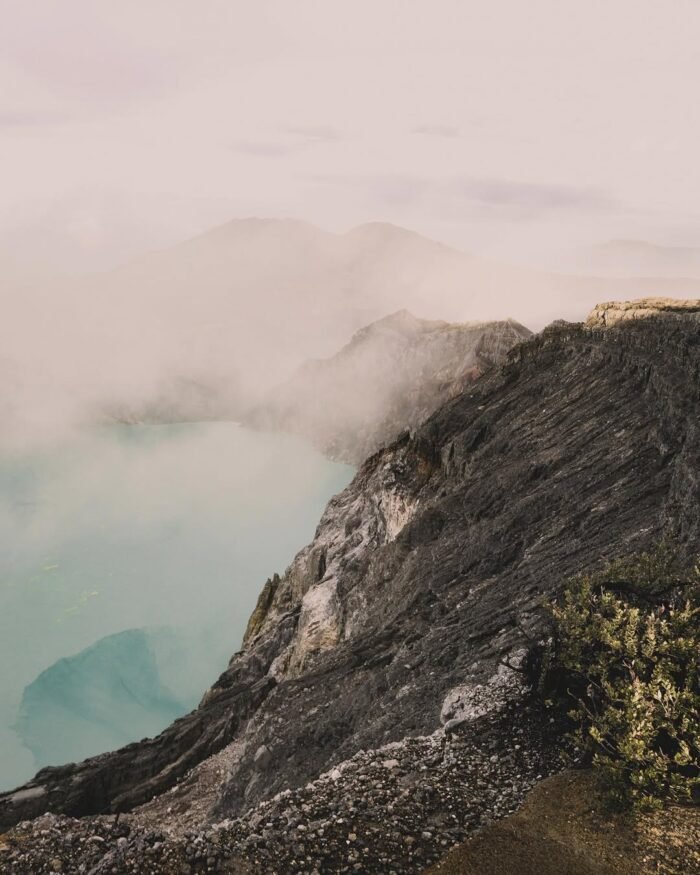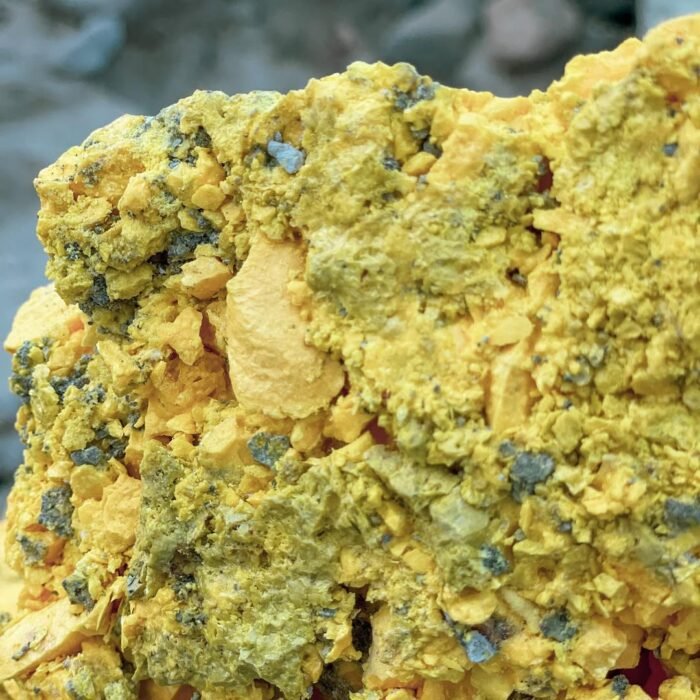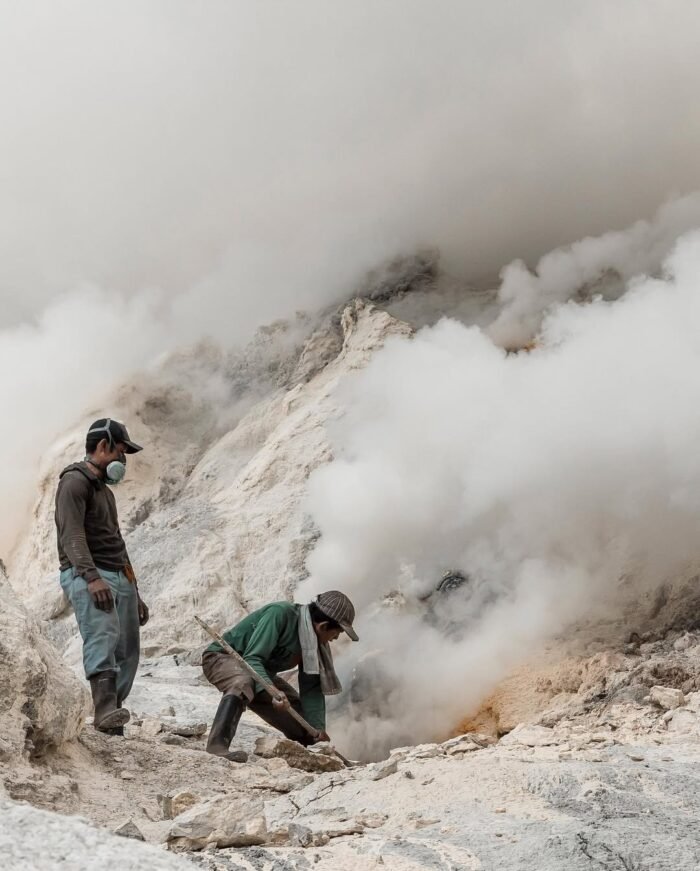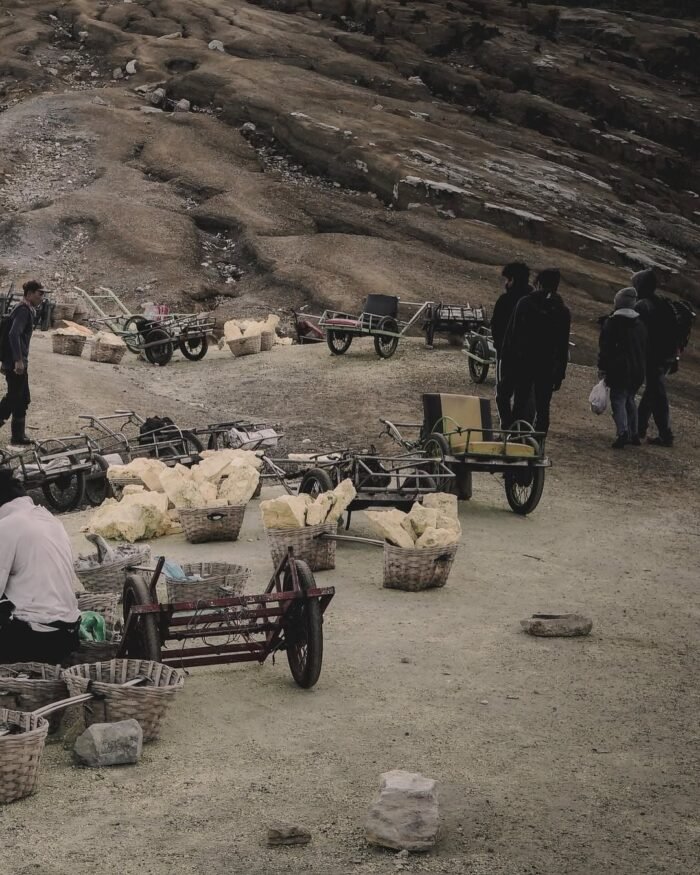Facts About Ijen Sulfur Miners: Harsh Conditions, Labor-Intensive Process, And Economic Realities At Ijen Volcano
The facts about Ijen sulfur miners reveal a story of incredible human endurance, dangerous working conditions, and the unique volcanic environment that shapes their daily lives. The Kawah Ijen volcano is in East Java, Indonesia. It is famous for its sulfur mining operations, which take place in one of the most dangerous workplaces in the world.
READ ALSO: Ijen Crater Tour from Banyuwangi
This article talks about important facts about these miners, where they work, and the problems they face.
The Unique Environment of Ijen Crater
Ijen Crater, located in East Java, is a remarkable stratovolcano within a vast 16- to 20-kilometer-wide caldera. At its heart lies a nearly 300-meter-deep crater, which is home to the world’s largest acidic volcanic lake. With a pH as low as 0.2, the lake’s water is highly corrosive and gives the lake its striking turquoise color.

Instagram.com @krisna_ubaidillah
However, the area is best known for its sulfur miners, who work in extremely dangerous conditions. They extract solid sulfur from the crater while braving toxic gases and carrying heavy loads up steep trails. It’s a testament to their resilience.
Furthermore, the volcano’s fumaroles emit sulfurous gases that can reach temperatures of up to 600°C, especially during periods of increased volcanic activity. One of the most mesmerizing sights at Ijen Crater is the blue fire phenomenon. Sulfur gases ignite to create glowing blue flames visible at night.
READ ALSO: Ijen Volcano Blue Flames from Pemuteran Bali
This wonder, along with the facts about the Ijen sulfur miners, continues to amaze scientists and tourists alike.
The Sulfur Mining Process
Sulfur is mined in Ijen, but the process is difficult and dangerous. Ijen sulfur miners collect sulfur by piping volcanic gases through ceramic pipes. These gases cool and turn into liquid sulfur, which then solidifies into bright yellow chunks at the end of the pipes.

Instagram.com @she_shoujo
Miners use iron rods to break solid sulfur into pieces. They put these pieces into a bamboo basket called a “Pikula.”
Another important fact about Ijen sulfur miners is the heavy loads they carry. Each miner carries 70 to 90 kilograms of sulfur up a steep path 300 meters from the crater.
Then, they walk three kilometers to the weighing station. Many miners repeat this journey twice a day.
In total, they transport up to 14 tons of sulfur every day. This is about 20% of the sulfur that the volcano produces every day. These facts about the Ijen sulfur miners show their strength and endurance.
Working Conditions and Health Risks
The facts about Ijen sulfur miners show that their working conditions are extremely harsh. These miners spend long hours near the Ijen volcano, where the air is filled with toxic gases like hydrogen sulfide and sulfur dioxide. These gases can cause serious damage to their lungs, eyes, and teeth.

Instagram.com @kawahijenindonesia
Also, many miners cannot afford the right safety equipment, like masks, gloves, or protective clothing. This means that they are directly exposed to dangerous fumes and an acidic environment. The facts about Ijen sulfur miners also show that long-term exposure to sulfur fumes often causes respiratory problems and other ongoing health issues.
Sometimes, the area has phreatic eruptions, which are sudden steam explosions from the lake. These eruptions are very dangerous. In 1976, an eruption killed 49 miners.
These facts about Ijen sulfur miners show the dangers they face every day and the health problems they have when working in these extreme conditions.
Economic Aspects and Livelihood
The facts about Ijen sulfur miners show that mining sulfur in Ijen Crater is a traditional and difficult job. The work helps the local economy by providing money for many families.
Miners make about $5 to $7 per trip, which equals about $13 per day. This is not a lot of money, but it’s enough to cover your daily expenses. The work is very hard and risky.
They collect sulfur, which is important to many industries. It is used to make things like rubber, matches, insecticides, fertilizers, cosmetics, batteries, medicines, sugar, and film. Most of the sulfur is sent to countries like China and other countries in Southeast Asia.

Instagram.com @krisna_ubaidillah
The facts about Ijen sulfur miners also show that although machines can make mining safer and faster, local miners prefer to stick to traditional methods. They rely on this way of mining for their livelihoods and don’t want to lose their jobs.
Historical and Cultural Context
The facts about the Ijen sulfur miners show a long history. People have been mining sulfur in Ijen Crater since the 16th century.
In the past, miners used bamboo canoes to cross the acidic lake, which was extremely dangerous. This shows how closely humans and this harsh environment are connected. Today, there are about 200 to 300 miners working in Ijen.
The facts about Ijen sulfur miners show that they work in shifts that last 15 days. After each shift, they rest before going back to work. Their work is risky, but it helps them support their families and maintain a tradition that has lasted for centuries.
Environmental Impacts
The facts about Ijen sulfur miners show that volcanic activity and sulfur mining cause environmental problems. Acidic lakes and toxic gas emissions damage local plants and increase air pollution in the area.
On top of that, the gases released during mining, like sulfur dioxide, have a negative impact on the health of miners and people living near the volcano. These gases are also damaging the crops and agriculture in the area. All in all, the facts about Ijen’s sulfur miners show just how serious the environmental impacts are on nature and the communities surrounding the volcano.
Resilience and Challenges: The Facts about Ijen Sulfur Miners
The Ijen sulfur miners are an example of resilience in the face of natural disasters and hard work. These miners have to deal with toxic gases, extreme heat, and physically demanding labor to extract sulfur from one of the most unique volcanic sites in the world. Their work supports the local economy and keeps centuries-old mining traditions alive.

Instagram.com @krisna_ubaidillah
But the risks to their health are serious, including respiratory problems and injuries. This shows that better safety protocols are really needed. On top of that, we need to think about the environment, so we have to make sure our mining practices are sustainable to protect the miners and the communities around them. So, we can keep this important cultural heritage alive and well for years to come.